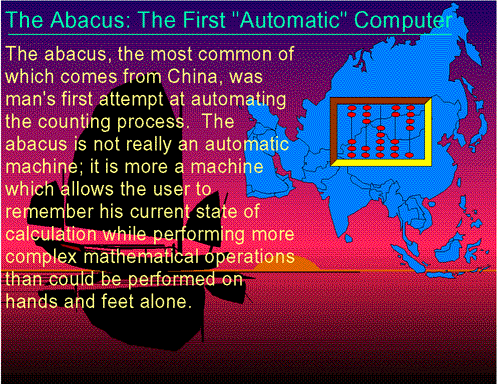A Primitive Calculator
 |
Meanwhile in Asia, the Chinese were becoming very involved in commerce with the Japanese, Indians, and Koreans. Businessmen needed a way to tally accounts and bills. Somehow, out of this need, the abacus was born. The abacus is the first true precursor to the adding machines and computers which would follow. It worked somewhat like this:
The value assigned to each pebble (or bead, shell, or stick) is determined not by its shape but by its position: one pebble on a particular line or one bead on a particular wire has the value of 1; two together have the value of 2. A pebble on the next line, however, might have the value of 10, and a pebble on the third line would have the value of 100. Therefore, three properly placed pebbles--two with values of 1 and one with the value of 10--could signify 12, and the addition of a fourth pebble with the value of 100 could signify 112, using a place-value notational system with multiples of 10.Thus, the abacus works on the principle of place-value notation: the location of the bead determines its value. In this way, relatively few beads are required to depict large numbers. The beads are counted, or given numerical values, by shifting them in one direction. The values are erased (freeing the counters for reuse) by shifting the beads in the other direction. An abacus is really a memory aid for the user making mental calculations, as opposed to the true mechanical calculating machines which were still to come.
Works Cited: http://lecture.eingang.org/abacus.html
The abacus is not a calculator per say, it does not actually perform calculation but give the user a way to mark where they are at in a calculation they are performing. Allowing for the use of large calculations. Yet these devices have been used for many applications over time from trade, government, military, education, and the sciences. Different cultures have varying abacus designs based on their number system. The construction of the abacus is an art form in and of itself, consisting of multi rows of beads. The beads can be made from a variety of materials and have different color schemes.
ReplyDeleteRecently I was reading a book where the author told a story about his travels, in the 1980s, to an astronomy lab in China where one of the astronomers was still using an abacus in his calculations of star points. It has always been fascinating to me how the abacus works and the fact it has been around for ages and is still in use.